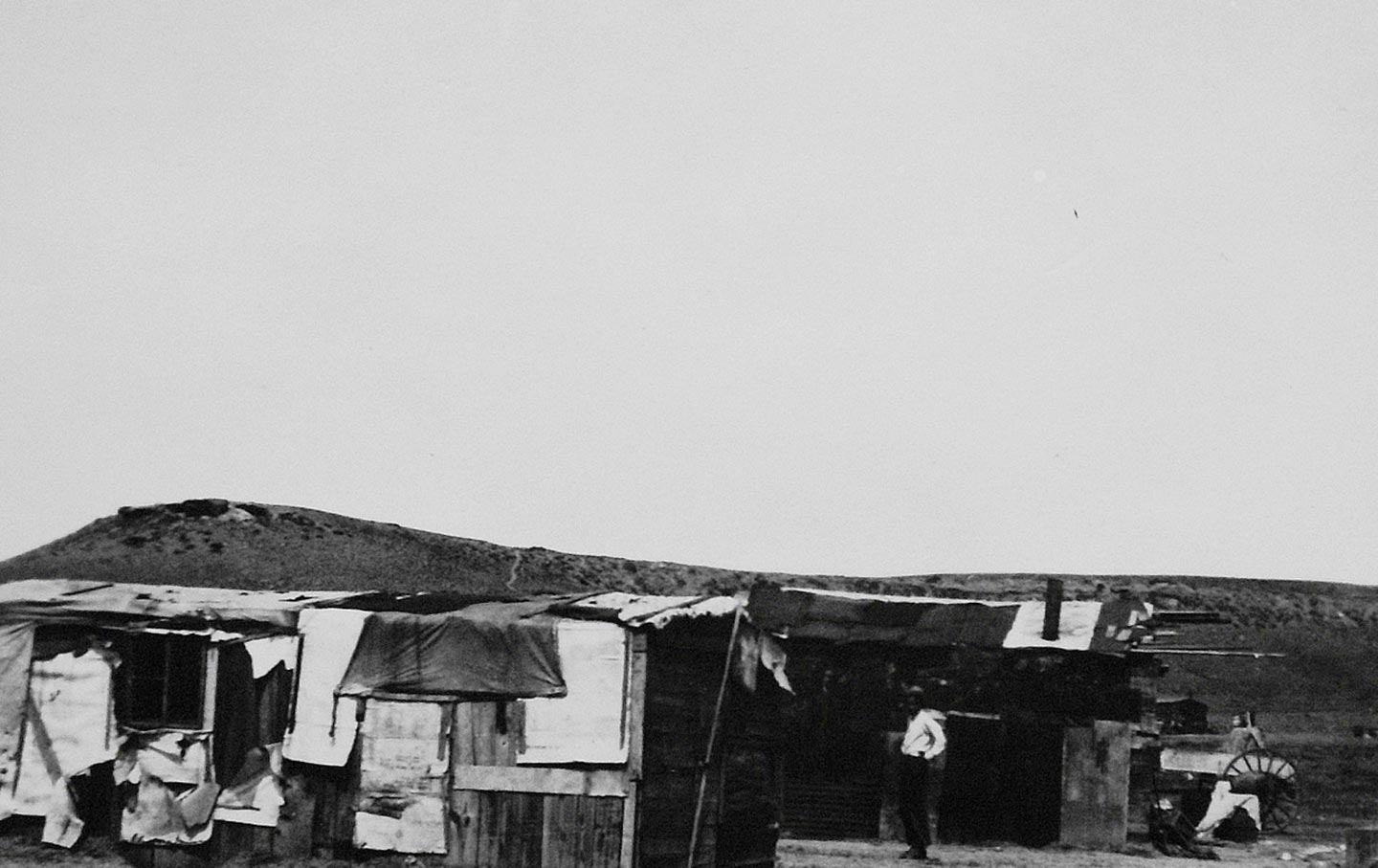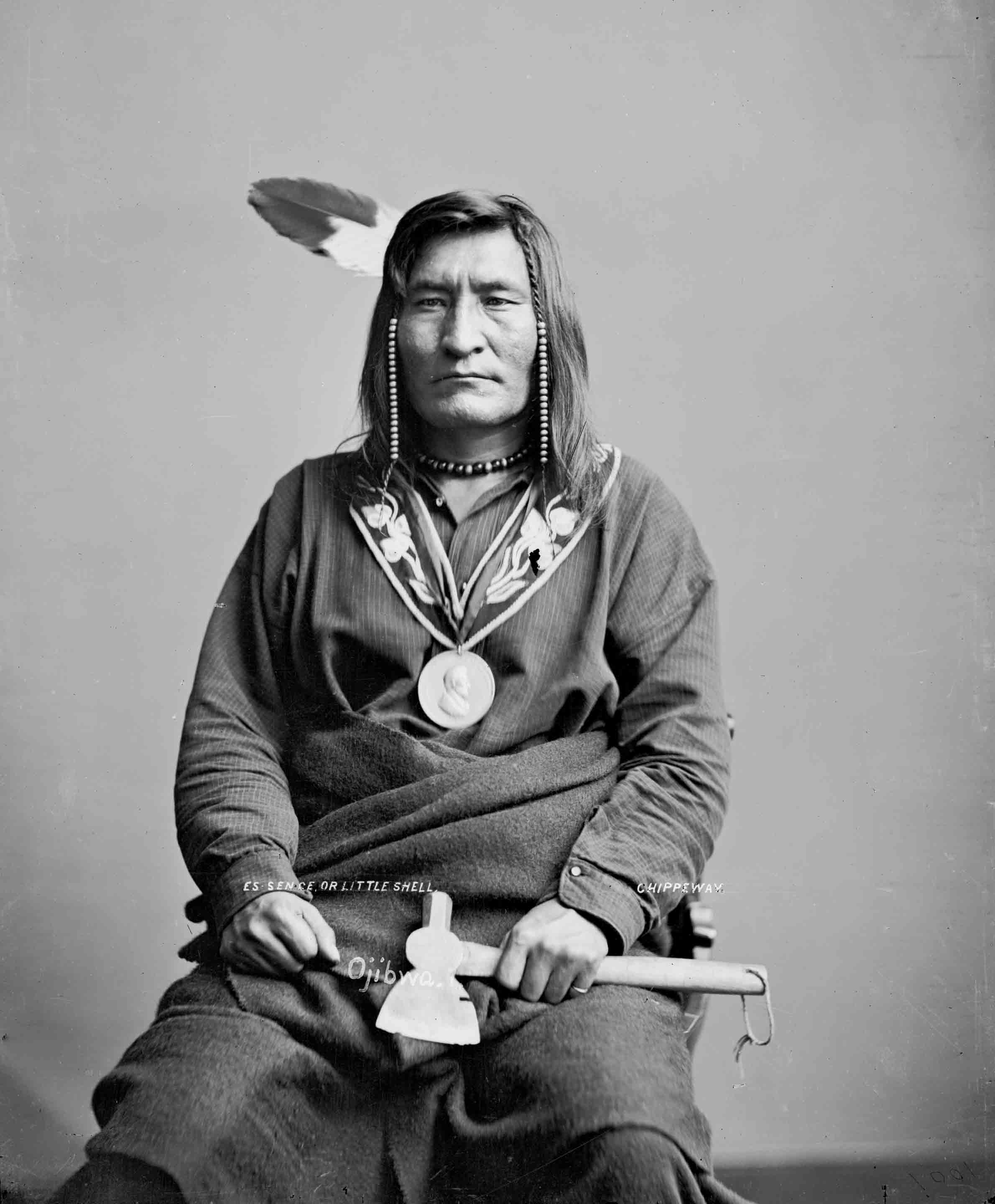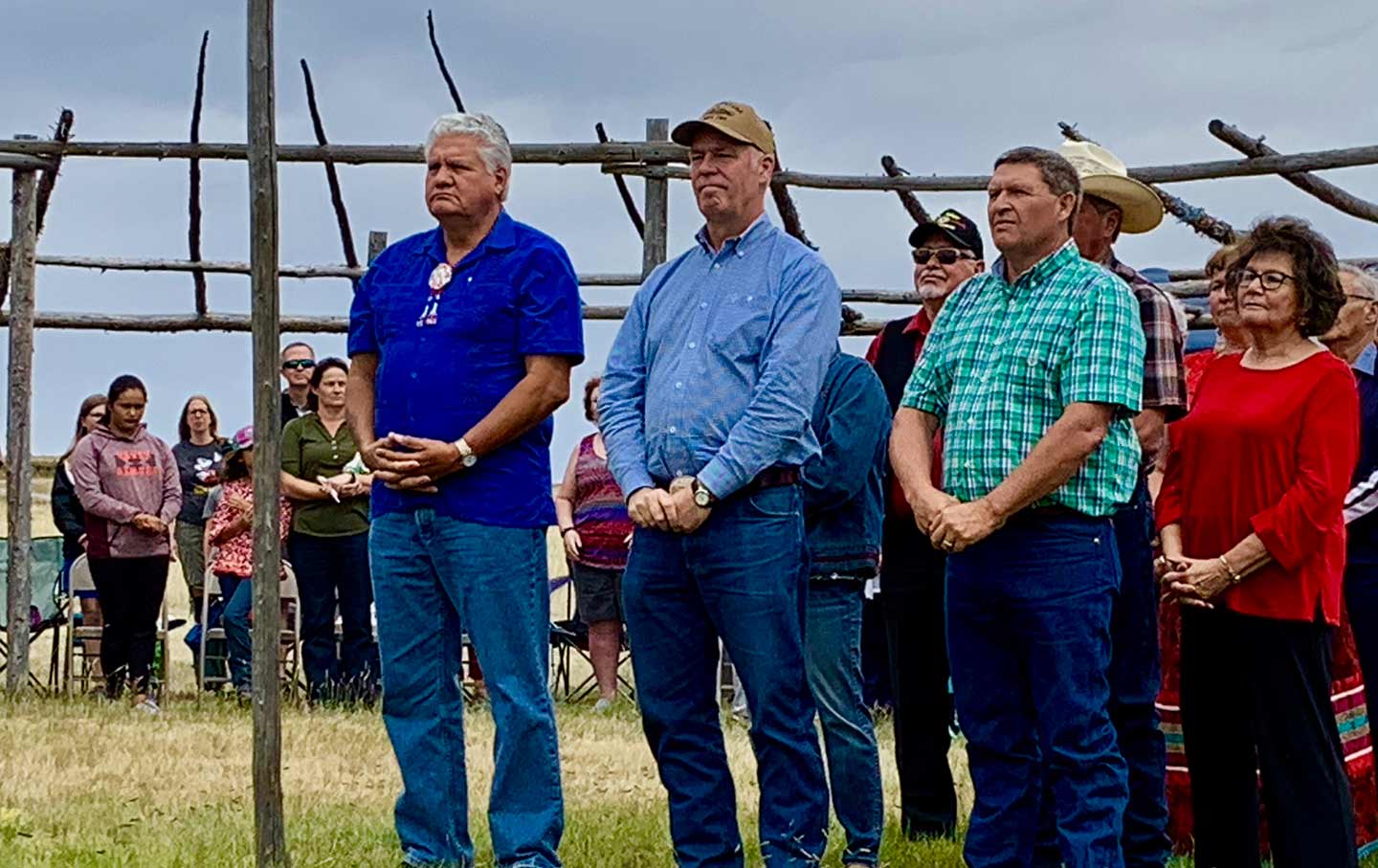On a hot August afternoon, tribal elder Phyllis McGillis stepped onto the sun-baked porch of her trailer home in Great Falls, Montana and looked down the road. Her younger sisters were on their way to discuss a stunning bit of news: Their family’s five-generation fight was approaching its end. A bill to federally recognize the landless Little Shell Tribe of Chippewa Indians was about to become law.
Two cars rumbled up the dusty lane, past the abandoned egg processing plant and toward the treeless rise called Hill 57. Most native families left this makeshift neighborhood years ago, but not McGillis. Her feisty papillon barked a welcome to Wanda Guzman and Cherri Azure as they climbed the stairs. Inside, Azure pulled kitchen chairs into the living room, where the walls are lined with family photos, including a long row of relatives’ portraits in military uniforms, some in black-and-white and others in full color.
Together, the sisters began recalling their past. They agreed that life was easier for them than it had been for their parents, who attended segregated public schools where all native children were assigned to a single classroom regardless of age. Easier, they said, but not easy.
“We were called half-breeds,” McGillis explained. “We didn’t quite fit in.” So, they stuck close to Hill 57, where many native people who did not live on one of the state’s seven reservations were allowed to settle, beyond the reach of city water mains and sewer pipes. They pumped and hauled their water from a common well and hunted game in the fall. They jerry-rigged go-carts in the summer and used old car hoods for sledding in the winter. They also attended tribal meetings with their parents, who, like their grandparents and great-grandparents, wrote petitions and lobbied lawmakers to secure their civil rights as indigenous people.
“When we were growing up, I mean, we truly did not belong anywhere,” Guzman said. “We knew who we were, but we didn’t belong anywhere.” For their entire lives, these three sisters have been waiting for the federal government to legally acknowledge the existence of more than 5,000 American Indians who descend from the followers of a Chippewa (Ojibwe) Chief named Thomas Little Shell. The tribe is not alone in this struggle for recognition.
The Little Shell—a polyethnic people primarily of Chippewa, Cree, Assiniboine, and Métis descent—are one of more than 400 unrecognized tribes across the United States. Many of these tribes have been denied federal recognition through administrative and legislative processes that are notoriously slow and unresponsive. The Bureau of Indian Affairs has only recognized 18 tribes since 1978, when the US first established a procedure for administrative acknowledgement. Until recently, Congress provided a more productive path, recognizing 38 tribes over the same time period. But most of those successes happened early: Since 1995, Congress has passed only two bills—recognizing seven tribes between them—while more than 80 tribal recognition bills have died.
Popular
"swipe left below to view more authors"Swipe →
Today, the Little Shell people are poised to disrupt this trend of inaction and dysfunction. This spring, after 12 years of trying, their bill finally passed the US House of Representatives as a stand-alone measure and the Senate as an amendment to the National Defense Authorization Act (NDAA). To become law, it now must be approved by a joint conference of the House and Senate Armed Forces committees, which will resolve differences between the two chambers’ existing versions of the NDAA. Before the year is up, the entire package must then clear both chambers a second time. If lawmakers complete these steps, they will finish a legislative task that has been completed only twice in a quarter century. And for the first time in US history, they will begin a government-to-government relationship between the United States and the Little Shell people.
McGillis, who turns 70 this year, is watching closely and hoping that her generation will witness what previous ones did not. “A lot of them wanted recognition up until they died. That was their dream,” she said. “So many of them passed away and never saw that dream fulfilled.”
Unlike many tribes in the United States, the Little Shell people have a thoroughly researched and meticulously documented history. In 2012, tribal historian Nicholas Vrooman, a white scholar who held a doctorate in history from the University of Montana, published a 465-page volume titled The Whole Country was… One Robe: The Little Shell Tribe’s America. Vrooman passed away unexpectedly earlier this year, but his words remain. “Since the Indian Wars of the nineteenth century,” he wrote, “the Little Shell have been subject to an active campaign of elimination from the culture-scape of Montana.”
This campaign accelerated in 1892, when Chief Little Shell rejected a federal offer of 10 cents per acre for 10 million acres of land. Through his lawyer, John Bottineau, he opposed ratification of the treaty and protested a decision by US Indian Agent John Waugh to purge 425 “half-breeds” from an enrollment list of those who would be permitted to settle on the Turtle Mountain Reservation in North Dakota.
While the politics of the “10-cent treaty,” as it came to be known, played out in Washington DC, Chief Little Shell and his followers struggled to survive in Montana. Bison populations had collapsed a decade earlier, and the community was without a land base. Many tribal citizens were forced to camp on the outskirts of Great Falls, Butte, and Helena. They earned a meager income by staging dances and selling traditional wares, until even the market for cultural spectacle was snuffed out.
Earlier that year, E.D. Weed, US District Attorney for Montana, had written a letter to US Secretary of State William Wharton alleging that “complaints are constantly being made by settlers against depredations” of “a large number of Cree Indians” and that steps should be taken “to remove these Indians from the Territory of the United States.” Weed’s opinion carried weight and was shared by other influential politicians, who applied pressure on Congress to pass the 1896 Cree Deportation Act, appropriating $5,000 to deport “Cree refugees” from Montana by military force. Legislators used the reductive and often inaccurate term “Cree” to justify this act of ethnic cleansing, because they believed the Cree had migrated into the United States from Canada.
In June of that year, Lt. John J. Pershing—who would later achieve fame commanding American troops in WWI—led hundreds of African American soldiers through the state of Montana, forcing more than 500 landless Indians across the Canadian border. As the century turned, some of these people settled in Alberta and Saskatchewan, while others returned to Montana and North Dakota to continue their fight for political agency and economic opportunity. After Chief Little Shell’s death in 1901, a young leader named Rocky Boy appealed to President Theodore Roosevelt and persuaded Congress to appropriate $30,000 to purchase land for the tribe. The Rocky Boy Reservation was created in 1916, but in the process, Bureau of Indian Affairs Agent James McLaughlin cut another 233 so-called “half-breed” people from the enrollment lists.
Descendants of those cut or excluded from enrollments lists on the Rocky Boy and Turtle Mountain reservations make up a significant part of today’s Little Shell tribe. Kim McKeehan, a Little Shell Tribal Council Member and mental health therapist, stands among them.
“One of the most insidious impacts of intergenerational trauma is identity confusion,” McKeehan said. “We lose our connection to our land, economy, language, families, and ceremonies. I feel a longing for reconnection with all of those things.”
McKeehan believes one of the tribe’s most pressing needs is to heal the trauma they have endured, from forced deportation over a century ago to current economic isolation and political disenfranchisement. For her, the ongoing fight for federal recognition is a way to realize that objective.
“Intergenerational trauma has oppressed our community and made it very difficult for people to achieve community identity,” she said. “Federal recognition will give our tribe resources to change that.”
In the United States, there are 573 federally recognized tribes, which have several advantages relative to their unrecognized peers. According to Kevin Gover, a former assistant secretary of Indian Affairs under President Bill Clinton, the two most important benefits are self-governance and public funding. The federal government is legally obligated to honor these commitments to recognized tribes as compensation for appropriating their land and resources—but for unrecognized tribes, no such obligations exist.
“With federal acknowledgement comes eligibility for Bureau of Indian Affairs funds, Bureau of [Indian] Education funds, and Indian Health Service Funds to meet needs in those communities, so it’s tremendously important in that respect,” said Gover, a citizen of the federally recognized Pawnee Nation and current Director of the National Museum of the American Indian in Washington DC. “It also gives these tribes varying degrees of governing authority over their people and their land.”
When Gover began working at the BIA in 1997, the Little Shell had been lobbying the federal government for over a century. The tribe had submitted a petition for federal acknowledgement through the BIA in 1978, immediately after the Bureau began processing claims, but had yet to receive a final determination. Gover studied their case and found it compelling.
He noticed that the tribe “had virtually universal support” from Montana’s congressional delegation, county officials, and the state’s 11 federally recognized tribes. In 2000, as Montana moved to recognize the Little Shell on a state level, Gover proposed that the tribe should receive federal recognition, but senior BIA staff members opposed the decision, arguing that it lacked precedent. The tribe’s petition was left in limbo for nearly another decade.
Then, in October 2009, the BIA officially reversed Gover’s proposed finding, issuing the Little Shell a “Negative Final Determination.” Dismayed by this u-turn, the tribe quickly filed an appeal, which took the BIA an additional four years to review. By the time the BIA finally responded—by remanding the appeal directly to the Secretary of Interior—the Obama administration was considering an overhaul of the entire tribal acknowledgement process, and in January 2014, the tribe’s appeal was suspended pending promulgation of these new procedures. Fourteen years had passed since Gover tried to end the Little Shell’s long wait, but the tribe’s petition was still lost in an administrative maze.
“I will say this in defense of all those who make it hard,” Gover said, looking back on those years. “It should be hard, because it’s a big deal for the United States to say to state and local governments that you now have a new government with authority in your territory and among your people. But there’s no need for it to be absurd, and it often feels like we’ve crossed over into absurd in how these petitions are processed.”
The Obama administration simplified the BIA process for federal acknowledgement in 2015, but Little Shell Tribal Chairman Gerald Gray believes the changes didn’t go far enough.
“We’d still be waiting decades if we went through the [BIA] Office of Federal Acknowledgement,” he said. “We’d be waiting forever.”
The tribe approached Montana Senator Jon Tester immediately after he was elected as a Democrat in 2006. In January 2007, Tester introduced his first bill in the Senate: The Little Shell Tribe of Chippewa Indians Restoration Act. He’s reintroduced it in every congressional session since then. The bill conveys federal recognition to the tribe and requires the federal government to acquire a trust title to 200 acres of land for their use.
“This bill will help correct a historical injustice perpetrated against the Little Shell Chippewa Tribe, who have fought for generations to be recognized,” said Tester. “It’s time the federal government acknowledge what the tribes of Montana, the state of Montana, and most importantly, the Little Shell Tribal members themselves know to be true.”
Senator Steve Daines and Representative Greg Gianforte, both Montana Republicans, also support the bill and have worked hard to move it forward. While Gianforte has twice gotten the bill passed in the House, the Senate has proven a much greater challenge. In December, Utah Republican Senator Mike Lee refused to remove his hold on the bill, even after Daines made a dramatic plea from the Senate floor in the final days of the last congressional session. (When contacted by The Nation, Lee’s office declined to comment on the senator’s position.)
These events convinced Tester that the only way to overcome Lee’s hold would be to include the bill in a must-pass piece of legislation. On June 13, he filed amendment #412 to attach the measure to the annual National Defense Authorization Act (NDAA), an appropriations package that has received congressional approval for 58 consecutive years. But Senate Majority Leader Mitch McConnell agreed to attach the bill only if Daines was listed as the lead sponsor, so, on June 18, Daines filed his own copy of Tester’s amendment. McConnell gave it the green light, and it passed with the NDAA on June 27.
Daines is up for re-election to a second term in 2020, and Alex Street, an associate professor of political science at Carroll College in Helena, points out that “while he’s not the most vulnerable member of McConnell’s caucus, he’s also not the least vulnerable.” According to a poll by the University of Montana, Daines has an approval rating of 47 percent, four points lower than Tester’s. In a sparsely populated purple state where elections are routinely decided by 10-20,000 votes, it’s also worth noting that Montana’s 70,000-plus indigenous residents represent a significant voting bloc.
While it’s likely, then, that McConnell had the interests of his caucus in mind as he jockeyed Daines into the lead sponsorship on Tester’s bill, what matters is that after 12 years, the Little Shell bill is finally in an advantageous position.
“The House passed Little Shell recognition as a stand-alone bill,” said Julia Doyle, Daines’s press secretary. “That’s a good sign for it to stay in the NDAA as it goes through the conference process.” Conferees began meeting earlier this month, and Josh Clause, a Washington DC based lawyer and lobbyist, who has worked with the tribe for years to pass the bill, agrees that the outlook is bright.
“The conference process started slowly, so it [will] be October before passage,” he said, “but I’m cautiously optimistic that the conference will retain the Little Shell Restoration Act because it enjoys such broad and bipartisan support.”
Federal recognition alone cannot remove the challenges that many native communities face today, but it can empower tribes to mitigate those challenges and seize future opportunities. So, if one tribe’s 130-year fight for federal recognition ends this year, what might it mean for others that continue?
Currently, there are six tribes with petitions in process at the BIA and six more who will become petitioners after they provide additional documentation. But positive outcomes are unlikely. Since 2000, the BIA has made a final determination on 24 cases, but only four of them were positive.
And what about Congress? The Little Shell bill would be the second recognition bill passed this session, following approval of one last year recognizing six Virginia-based tribes. Is this a sign that Congress is prioritizing recognition bills for the first time since the mid-1990s?
“I don’t assume the floodgates are about to open,” said Gover. “I think it’s more likely we’ll go back to no recognition bills making it through the process.
“My only hope,” he added, “is that those tribes with a legitimate historical case to make for federal recognition don’t give up because justice may be slow, but it also arrives.”
This notion of a possibility that becomes probable through ancestral effort—that it took five generations of Little Shell people to deliver justice for future generations—places Phyllis McGillis in a bittersweet state of mind.
“It’s been a long, hard fight, and I would be happy,” she said, “but I would also feel very sad because of all the people that waited so long to see that day come and aren’t alive to see it.”
“Yeah,” her sister Cherri replied, “but we are here, and because of them, we would be able to see it, and that would be awesome.”





